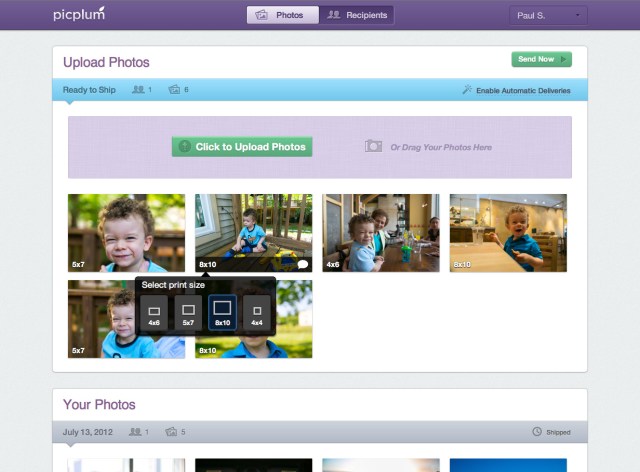Is this the beginning of the end for PicPlum, the Y Combinator-backed photo-sharing and printing startup that debuted back in the summer 2010? Today, co-founder Paul Stamatiou announced via blog post that he has joined Twitter full time, while PicPlum’s other co-founder, Akshay Dodeja, Stamatiou noted, has since moved on to a job with the new Live Nation Labs. PicPlum’s service will be actively maintained in Dodeja’s spare time, Stamatiou says, perhaps somewhat optimistically. Meanwhile he will remain an advisor.
According to the blog post, which focuses more on Stamatiou’s new position at Twitter as an Experience Designer on the Growth Team, led by Nancy Broden, PicPlum is not being shut down, and the founders are looking for help running the company, “from marketing to customer support,” the post reads. Stamatiou tells TechCrunch that PicPlum still brings in regular orders and revenue. (Though apparently not enough to keep its founders there full time.)
PicPlum, for those unfamiliar, allows users to send in their digital photos for printing, encouraging users to select only the best, high-quality photos (hence the startup’s name). The photos are printed on high-quality paper and packaged into attractive envelopes prior to shipping. Because the experience is more like receiving a photo “gift” than are the mass printouts like those done via photo printing powerhouses Shutterfly and Snapfish, PicPlum catered to those who wanted to share prints with others, in addition to receiving prints for themselves.
As a previous user of the service, I enjoyed the packaging and the fact that it forced me to be more thoughtful about print selection, but PicPlum seemed to stagnate in terms of its next steps for product development. Although beautifully designed on the web, PicPlum failed to launch a native mobile application on either iOS or Android, despite the fact that the majority of users’ pictures today come from mobile phones. On Flickr, for example, various editions of the iPhone have long since accounted for the majority of photos hosted on its site.
PicPlum went through a major revamp last summer, introducing a new pay-as-you-go pricing option at $0.50 per print and other changes, but again nothing for mobile users interested in a dedicated app. Instead, you had to email photos from your phone’s Camera Roll, which for larger batches, became time-consuming. At the time, PicPlum noted that a third of its users’ photos came in from mobile devices, including the iPhone 4 and 4S, at the top of the list.
While PicPlum waited to go fully mobile, photo giant Shutterfly has come back with a vengeance, acquiring mobile photo sharing startups left and right to beef up its own mobile photo sharing and printing app, which was newly relaunched in December. (And done well, I might add).
In addition, the past year or so seems to have been especially tough for many photo-sharing startups. ZangZing is gone, Gush folded, ThisLife, as noted above, sold to Shutterfly, and Snapjoy went to Dropbox, for example. A few others have stuck around or pivoted, but how long will they last, is the question we’re asking now. With both of its founders engaged elsewhere, it’s tough to believe that PicPlum won’t also close shop in the months ahead if it can’t find others to believe in its vision and join.
But co-founder Dodeja is still hopeful. “Picplum is not shutting down and is pretty much fully automated. My ideal goal is to find a new team that is passionate about the space and is excited to take it forward,” he tells us.
He also noted that the startup began to have acquisition talks in August with multiple companies, but the two founders instead decided to accept personal offers that were a better fit for them. “I am excited to be back in the music space,” he says, referencing his previous company Mugasha.
We asked PicPlum’s founders if they could share some numbers indicating the service’s current traction, and will update if we hear back.
At the end of the day, moving on to new jobs while keeping the startup up-and-running is at least an honest move for the two founders, when compared with joining a new firm via “acqui-hire” just because you were in need of an exit. For PicPlum’s user base, however large or small, it’s also likely to be a welcome decision.

